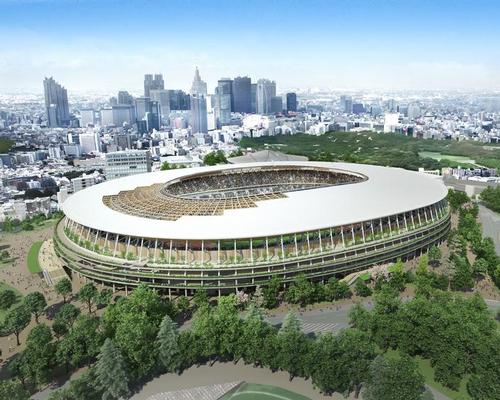13 Dec 2016
Construction begins on Kengo Kuma's National Stadium for 2020 Tokyo Olympics
BY Kim Megson

Construction work has kicked off on Tokyo’s new National Stadium, the Kengo Kuma-designed stage for the 2020 Olympics and Paralympics.
The design by the Japanese architect was chosen to replace Zaha Hadid Architects’ original scheme – ostensibly due to the rising cost of that project – in December 2015, and received the green light two months ago. Kuma’s stadium is estimated to cost 150bn yen ($1.5bn, €1.3bn, £1.1bn) to build.
Construction company Taisei Corp and building planner Azusa Sekkei Co have been contracted to complete the work, which is being overseen by the Japan Sport Council – organiser of the Games. The project is expected to be finished by the end of November 2019.
Kuma chose a wooden lattice design for the stadium, which evokes traditional styles seen in
Japanese shrines and pagodas and blends in with the surrounding forests through its heavy use of landscaping. The structure will use Japanese-grown larch in its wood as well as steel composite roof and prefabricated panels to minimise costs and ensure a relatively quick construction timeline.
Speaking at the groundbreaking ceremony, Japan’s prime minister, Shinzo Abe, said: “The new image of the stadium will realise ‘an athlete first’ policy with the best universal design in the world and some Japanese flavour. I’m very confident that this can be the stronghold of sports and culture for the new era.
“When we scrapped the original plan last July, I vowed to make the new venue one that will be celebrated by the people and the athletes, a place that can generate dreams and inspiration.”
Recently-elected Tokyo governor Yuriko Koike, who has been a vocal critic of the bloated costs of hosting the Olympics, said that the National Stadium will symbolise “the legacy of the Games and environmental sustainability,” adding, “I hope it will be loved by people for a long time to come.”
Earlier this year Kuma told Sports Management's sister title CLAD that he wants the new stadium, and the 2020 Games more broadly, to symbolise today’s Japan – a country “whose culture and direction is totally opposite to what went before” due to a slowing down of both economic growth and the pace of life.
“This new direction can be called the age of maturity,” he said. “People are finding a new, slower kind of lifestyle. But slowdown is not bad. Slowdown is creating new types of culture, new types of lifestyle. Actually, when you look at Japanese history, it is not a history of expansion. We’re basically very slow and very quiet, and I’m happy to see us go back to that time of quietness.
“For the stadium, I have used a lot of wood because I think it’s an appropriate material to symbolise this change. We once lived together and aged together with wood. I want to go back to that kind of natural circulation with my work.”
Close Window